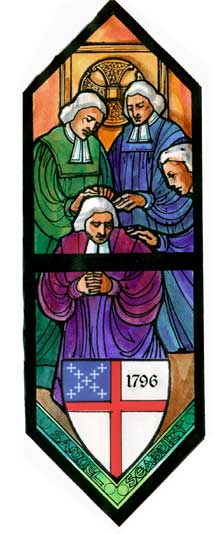|
|
|||

|
|||
Samuel Seabury Window
 Anglican worship came to America in the 16th century with the first colonists. Over the years, it grew significantly and spread throughout the colonies, but it was decimated in the 1770’s by the American Revolution. With notable exceptions, most Anglican clergy were loyalists (ordination vows included an oath of allegiance to the king); and most who did not flee were driven out. In the South, where the Church was closely tied to the civil authority, it lost its source of revenue, as well. After the war, the Church slowly regrouped, with formerly separate colonial churches coming together to form the Protestant Episcopal Church in the United States of America. Samuel Seabury was born in Connecticut and educated at Yale. Afterwards he traveled to England to study medicine until he became old enough for ordination, then returned to America as a missionary. He was rector of several churches in New England before the Revolutionary War; but after hostilities broke out, Seabury declared himself a loyalist and became chaplain to a royal regiment. After the war, he was chosen as the bishop of Connecticut and traveled to England for consecration; but at the time, Parliament had not yet worked out the logistics of consecrating Americans within the English succession. So Seabury traveled to Scotland, where he was consecrated in 1784, by a Scottish branch of the Anglican Church as the first bishop of the United States. In America, Seabury was a powerful voice for the continuation of the episcopacy, and the development of the American Book of Common Prayer. The next three American bishops were consecrated in England. With these three, Seabury took part in the first consecration of a bishop on American soil. Samuel Seabury’s consecration (an act traditionally performed by three bishops) is portrayed in this window, with the Canterbury Cross in the background reminding us that, though Seabury was consecrated in Scotland, the American Succession ultimately came through the English Church. Our own bishop, Herbert Thompson, is number 829 in the American Succession, descending from Samuel Seabury, who, in turn, descended in an unbroken line from the apostles. The Episcopal shield marks the birth of the Episcopal Church in the Christian story, and emphasizes the centrality of the apostolic succession, through which, for two millennia, bishops have become the guardians of the faith, united with the apostles in proclaiming the risen Christ as King and Lord.
Like Stars Appearing: The Story of the Stained Glass
Windows of St. George's Episcopal Church, Dayton, Ohio | |||
|
|||
